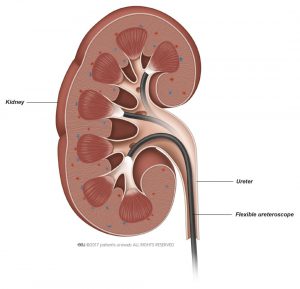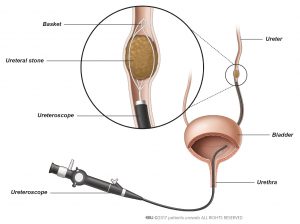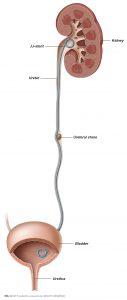What is ureteroscopy?
Ureteroscopy (URS) is a preferred method for the treatment of small- to medium-sized kidney stones located in any part of the urinary tract.
The procedure
- The procedure is typically performed with the patient under general anesthesia (asleep).
- During this procedure, a ureteroscope is inserted through the urethra and bladder into the ureter (a tube that carries urine from the kidneys to the bladder) or kidney.
- X-ray images with a contrast agent (dye) in the ureters may be used to allow the urologist to see where the stone is located and to rule out other abnormalities.
- The ureteroscope is long and thin with a tiny fiber optic camera at the end that is used to see beyond the bladder into the ureters.
- Once the stone is located, it is pulled out directly with a “stone basket” or a laser is used to break the stone into smaller pieces before they are extracted using the basket.
Some ureteroscopes are flexible like a thin, long straw. Others are more rigid and firm.
Preparation for the procedure
Always ask your doctor about the treatment-steps and any special instructions.
Instructions may include:
- When to stop certain medications, such as blood thinners.
- When to arrange pain medication after the procedure (if necessary). Discuss this early with your nurse and/or doctor.
- Arranging a ride home after your procedure.
- Not to eat, drink, or smoke for approximately 6-8 hours before the procedure to prepare for the anesthesia.
You may be asked to give a urine sample before the procedure to test for a urinary tract infection.
What to expect after the procedure
In some patients, a temporary small tube, called a stent, is placed in the ureter (Fig. 2). This stent facilitates urine flow to the bladder as the ureter can be swollen after the procedure. The stent is usually removed shortly after the procedure.
You may feel mild to moderate pain in your lower abdomen and you may have a strong urge to urinate. These symptoms are usually the result of the inserted stent. There is medication available to treat these symptoms, do not hesitate to ask.
What to expect back home
Your doctor or nurse will provide discharge instructions for rest, driving, and physical activities after the procedure.
If a ureteral stent was placed during the procedure your doctor will advise you when it needs to be removed. This can take anywhere between several days and a few weeks. The stent is removed during a quick procedure in the office that does not require any anthesia.
Because instruments were inserted into your urinary tract, you may experience several urinary symptoms for some time after surgery. These problems usually disappear in a few weeks.
Symptoms may include:
- A mild burning feeling when urinating
- Small amounts of blood in the urine
- Mild discomfort in the bladder area or kidney area when urinating
- Need to urinate more frequently or urgently
- Pain resulting from an internal abrasion that needs time to heal
Try to drink often, but in small quantities. Sometimes a blood clot can cause pain (colic). The urine contains a substance urokinase which will dissolve this clot.
If the pain remains despite pain killers, contact the hospital or your doctor.
What can I do the first week after surgery?
- Try to drink enough fluids: 1.5 liters daily (in small quantities) throughout the day to facilitate urine flow and the spontaneous loss of small stone fragments
- Try not to have sex within the first week after the procedure to avoid urinary tract infections
- Eat more vegetables and less meat to have a softer stool – constipation can make the possible discomfort from the stent worse.
When should I call my doctor?
- When you have a fever above 101 degrees
- When you experience a serious burning sensation (not mild) when urinating
- When you are unable to urinate
- When you see large amounts of blood in your urine, which is not relieved by rest or hydration
- When you continue to have severe pain in your side, despite painkillers
You should tell your doctor right away if bleeding or pain is severe or if problems last longer or worsen after you have been discharged.
Your doctor may prescribe an antibiotic to treat or prevent an infection or relieve your pain. You should report any signs of infection––including severe pain, chills, or fever—to your doctor right away.
Follow-up
A follow-up appointment will be scheduled before you leave the hospital. Follow-up may include:
- Discussing laboratory results
- Ultrasound or X-rays check
- Ureteral stent removal
Laboratory results
The removed stone is sent to the laboratory to determine its composition. This may take several weeks. Based on the laboratory results, along with blood and urine tests taken prior to treatment, your doctor is able to determine if you are at high risk of forming new stones.



